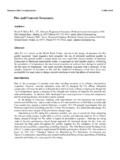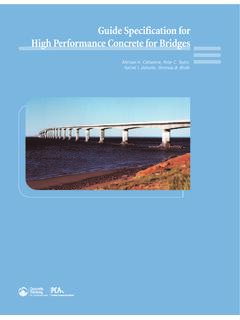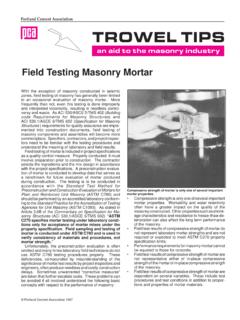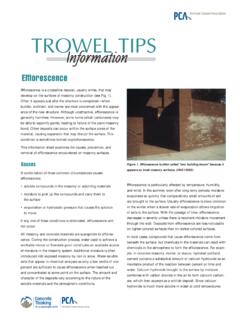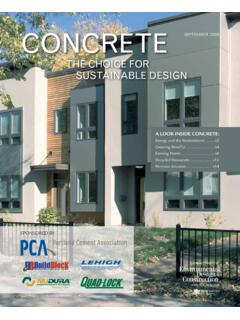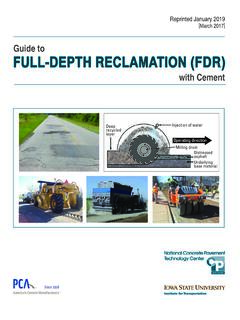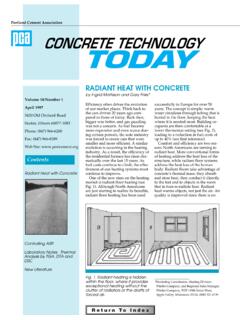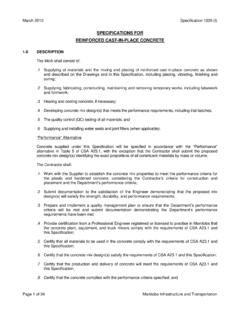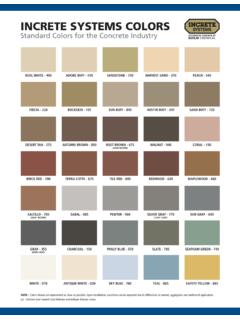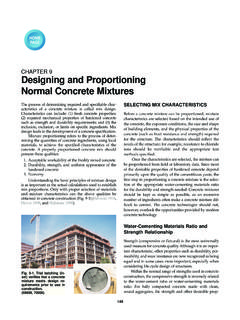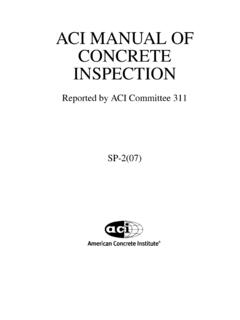Transcription of Solar Reflectance Values of Concrete
1 PCA R&D SN2982a Solar Reflectance Values of Concrete by Medgar L. Marceau and Martha G. VanGeem Reprinted by permission of Concrete International 2008 All rights reserved ]ca ce a s ee Intrinsic material properties can minimize the heat island effect BY MEDGAR L. MARCEAU AND MARTHA G. VANGEEM Surface and air temperatures in urban and suburban areas tend to be higher than those in adjacent rural areas. This phenomenon, commonly known as the heat island effect, is the result of many factors, but the Solar energy absorbed by the surfaces of pavement and buildings plays a major role. Because the heat island effect leads to increased demand for air conditioning and amplified levels of air pollution in cities, current and pending environmental rating systems for buildings l-3 encourage the use of construction materials that efficiently reflect Solar radiation and emit heat via radiant energy.
2 We recently conducted a studt to see how these properties vary among Concrete mixtures containing v(lriolls cementjtjous materjals and aggregate types. BASIC TERMS Solar rellectance The Solar Reflectance of an opaque material is a surface property reported on a scale of 0 to I, with I indicating that all of the Solar energy striking a surface is reflected back into the atmosphere and 0 indicating that none is reflected. Generally, light-colored materials have higher Solar Reflectance than dark-colored materials. Color isn't always a reliable indicator of Reflectance , however, as visible light represents only 47% of the energy in the Solar spectrum. Solar Reflectance is also commonly referred to as albedo. EmiDance Emittance, a measure of how well a surface lets go of heat via radiant energy, is also a surface property reported on a scale of 0 to I, with I indicating 100% 52 AUGUST 2008/ ConcretelnternaUonal emittance.)
3 Highly polished aluminum, for example, has an emittance of less than A black, nonmetallic surface, however, has an emittance of more than Most nonmetallic opaque materials at temperatures encountered in the built environment have emittance Values between and Solar rellectance index The Solar Reflectance index (SRI) is a composite value calculated using the equations in ASTM E1980, "Standard Practice for Calculating Solar Reflectance Index of Horizontal and Low-Sloped Opaque Surfaces." For a given set of environmental conditions, SRI is based on a surface's soJar Reflectance and emittance. TARGET Values Existing rating systems and a proposed standard3 provide incentives for building designers to use reflective hardscaping or roofing materials. For example, the Leader ship in Energy and Environmental Design Green Building Rating System for New Construction (LEED-NCTM) provides Sustainable Sites (SS) Credit 7, "Heat Island Effect.
4 " This system allows one point (Credit ) for using paving material with an SRI of at least 29 for a minimum of 50% of the site hardscape (including roads, sidewalks, courtyards, and parking lots). Another point (Credit ) is available for using low-sloped roofing with an SRI of at least 78 or steep-sloped roofing with an SRI of at least 29 for a minimum of 75% of the roof surface. As of August 2006, 62% of LEED projects qualified for Credit (the 23rd most commonly achieved point) and 53% qualified for Credit (the 31st most commonly achieved point)." 1 emi 0\ C typ for res ane For SRI as]: ort req mu EIS lea: of 2 san to ( sor TE So det cor inc as us pa mi (H roc Aft we At We th th ot us he ; an ed ~n Je lrd 'en re er ~, jes of ds, The LEED-NC Reference Guide7 provides a default emittance of for Concrete and Solar Reflectance Values of for "new typical gray Concrete " and for "new typical white Concrete .))
5 " It also reports default SRI Values for new gray and new white Concrete of 35 and 86, respectively. The default SRI Values for weathered gray and weathered white Concrete are 19 and 45, respectively. For comparison, the LEEI}-NC Reference Guide7 reports SRI Values of 0 and 6 for typical new and weathered asphalt surfaces, respectively. To meet the LEED-NC SS paving material requirement or the LEED-NC SS steep-sloped roofing material requirement for an SRI of at least 29, a Concrete surface must have a Solar Reflectance of at least using ASTM E1980 and an emittance of To meet the LEED-NC SS low-sloped roofing material requirement for an SRI of at least 78, a Concrete surface must have a Solar Reflectance of at least Currently, to qualify for these points, samples of the paving and roofing materials must be tested to determine the Solar Reflectance , except default Values of some materials are listed in the LEED-NC Reference Guide.
6 TEST PROGRAMS Small specimens Previous research by others8 was conducted to determine the factors affecting Solar Reflectance of Concrete . The parameters considered in the test program included the colors of the aggregate and cement as well as wetting, soiling, abrasion, and age of the Concrete surfaces. In all cases, test specimens were produced using mixtures with 1 part cement, parts water, parts sand, and parts coarse aggregate . Batches were mixed by hand and placed in 4 in. (100 mm) tall, 4 in. (100 mm) diameter plastic molds. After the Concrete was rodded, vibrated, and troweled, the molds were sealed. After 1 day, the molds were stripped and the specimens were cured in a saturated environment for 5 days. At the conclusion of curing, a 1 in. (25 mm) thick disk was sliced from the top of each Concrete cylinder using a water-cooled, diamond-tipped blade. The disks were then quartered.
7 When the test batches were prepared, no allowance was made for the absorption of the aggregates. Some of the specimens therefore had insufficient mixing water, the finished surfaces were irregular, and it was difficult to obtain reliable Reflectance results. For specimens produced using Concrete mixtures with sufficient mixing water, however, the investigators reported: Reflectance Values for 25-week-old Concrete produced with white and gray cement were to and to , respectively; Reflectance Values for aged, weathered, or abraded Concrete surfaces were affected by the Reflectance of the fine aggregate constituents; Fig. 1: Cementitious materials used in the current study: (a) portland cements; (b) fly ashes; and (c) slag cements. Numbers on each sample indicate the Solar Reflectance of the material ConcrelelDlemaUonal / AUGUST2oo8 S3 Fig. 2: Aggregates used in the current study: (a) fine aggregates; and (b) coarse aggregates.
8 Numbers on each fine aggregate sample indicate the Solar Reflectance of the material Fig. 3: Solar spectrum reflectometer used to measure Solar Reflectance of the constituent materials and Concrete surfaces in this study. The measurement head is the cylindrical piece in the upper right corner 54 AUGUST 2008 / '.maUona. Concrete Reflectance increased with hydration and stabilized at 6 weeks of age, with an average increase of about ; and Simulated weathering, soiling, and abrasion reduced the average Reflectance of Concrete by , , and , respectively. Flatwork specimens In the current study, commonly available Concrete constituent materials were proportioned, mixed, placed, and finished to replicate typical exterior flatwork. We selected materials, with colors representative of those used throughout the , from hundreds of samples sent to our laboratories. Figure 1 shows samples of the portland cement, fly ash, and slag cement types.
9 Figure 2 shows samples of the fine and coarse aggregates. Except for white portland cement, the portland cements were about the same shade of gray (Fig. 1). Individual particles of fine aggregate (typically erosion sediment largely consisting of granite, quartz, and feldspar) varied in color, and the lightest color fine aggregate was limestone (Fig. 2). Measuring Solar Reflectance Solar Reflectance Values were measured with a Solar spectrum reflectometer (SSR) shown in Fig. 3. For Concrete samples, the procedure in ASTM C1549 was followed, but the procedure was modified for measurements of powders (portland cement, fly ash, and slag cement) and fine aggregates. About (4 mL) of powder was placed on a 2 x 3 in. (50 x 75 mm) microscope slide, lumps in the powder were broken up, a second slide was placed over the powder, and pressure was applied to flatten the powder into a 2 in. (50 mm) diameter disc.
10 The resulting sample, sandwiched between the two microscope slides, was opaque. The effect of the glass slide on the measured value was eliminated by calibrating the device with a glass slide over a white standard reference material. For measurements on fine aggregates, about 3 (50 mL) of the aggregate was placed in a 1 in. (25 mm) deep, 2-1/4 in. (60 mm) diameter petri dish. To keep sand or dust particles out of the Reflectance measurement head, a polyethylene film was stretched over the measurement port prior to placing the dish in the instrument. The effect of the film on the measured value was eliminated by calibrating the device with the polyethylene film over the measurement port. For each powder and fine aggregate type, three samples were tested. No measurements were taken on coarse aggregate samples, as the samples were too small to completely cover the measurement port of the SSR, but too large to be measured using a collection of particles in a petri dish.
